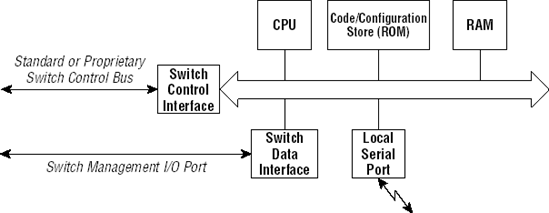15.3. Internal Switch Management Platforms
As discussed in Chapter 4, "Principles of LAN Switches," most high-performance switches today implement the real-time address lookup and frame forwarding functions in dedicated hardware. This is the only practical way to achieve wire-speed operation on large numbers of high-speed ports at a reasonable cost. There is generally no processor or software involvement in the actual switching process.
While it may not be used for real-time operations in the fast-path of the switch, most switches incorporate an embedded processor to perform myriad necessary housekeeping functions. Network management is simply one of these routine functions relegated to the embedded housekeeping processor. Figure 15-10 depicts a typical embedded processor platform capable of supporting management operation.
Figure 15.10. Embedded management platform

A CPU is needed, along with memory for storage of both the management code and the MIB data structures.[] The code store is usually implemented in nonvolatile, memory; EEPROM or Flash ROM is typically used. This allows the management capability to be available upon device initialization, without the need for either code download or a local mass storage device (i.e., disk), while still allowing code modifications, bug fixes, and minor upgrades without a hardware change. A serial port is normally provided for initial ...
Get The All-New Switch Book: The Complete Guide to LAN Switching Technology, Second Edition now with the O’Reilly learning platform.
O’Reilly members experience books, live events, courses curated by job role, and more from O’Reilly and nearly 200 top publishers.

